Electrostatic Potential and Capacitance Class 12 MCQs Questions with Answers
Class 12 Physics Chapter 2 MCQ Question 1.
The electrostatic potential on the surface of a charged conducting sphere is 100 V. Two statements are made in this regard :
S1: At any point inside the sphere, electric intensity is zero.
S2 : At any point inside the sphere, the electrostatic potential is 100 V
Which of the following is a correct statement?
(A) S1 is true, but S2 is false.
(B) Both S1 and S2 are false.
(C) S1 is true, S2 is also true and S1 is the cause of S2.
(D) S1 is true, S2 is also true but the statements are independent.
Answer:
(C) S1 is true, S2 is also true and S1 is the cause of S2.
Explanation:
The relation between electric field intensity E and potential (V) is,
E = – \(\frac {dV}{dr}\)
Where, Electric field intensity, E = 0 inside the
So that, \(\frac {dV}{dr}\) = 0
This means that V = constant. So, if E = 0 inside charged sphere1 the potential is constant or V = 100 V everywhere inside the sphere and it verifies the shielding effect also. So, it verifies the option (C).
![]()
Electrostatic Potential And Capacitance MCQ Class 12 Question 2.
Equipotential at a great distance from a collection of charges whose total sum is not zero are approximately
(A) spheres.
(B) planes.
(C) paraboloids.
(D) ellipsoids.
Answer:
(A) spheres.
Explanation:
For equipotential surface, these surfaces are perpendicular to the field lines. So there must be electric field, which cannot be without charge. So the algebraic sum of all charges must not be zero. Equipotential surface at a great distance means that space of charge is negligible as compared to distance. So the collection of charges is considered as a point charge.
Electric potential due to point charge is, V = Ke\(\frac {q}{r}\) which explains that electric potentials due to point charge is same for all equidistant points. The locus of these equidistant points, which are at same potential, forms spherical surface.
Chapter 2 Physics Class 12 MCQ Question 3.
A positively charged particle is released from rest in an uniform electric field. The electric potential energy of the charge
(A) The work done in Figure (i) is the greatest.
(B) The work done in Figure (ii) is least.
(C) The work done is the same in Figure (i), Figure (ii) and Figure (iii).
(D) The work done in Figure (iii) is greater than Figure (ii), but equal to that in Figure (i).
Answer:
(C) The work done is the same in Figure (i), Figure (ii) and Figure (iii).
Explanation:
As we know that, an equi potential surface is always perpendicular to the direction of electric field. Positive charge experiences the force in the direction of electric field. When a positive charge is released from rest in uniform electric field, its velocity increases in the direction of electric field. So (E. increases, and the RE. decreases due to law of conservation of energy.
![]()
Electrostatic Potential And Capacitance Class 12 MCQ Question 4.
Figure shows some equipotential lines distributed in space. A charged object is moved from point A to point B.
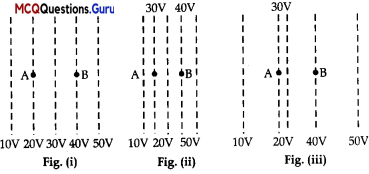
(A) The work done in Figure (j) is the greatest.
(B) The work done in Figure (ii) ¡s least.
(C) The work done is the same in Figure (i), Figure (ii) and Figure (iii).
(D)The work done in Figure (iii) is greater than Figure (ii), but equal to that in Figure (i).
Answer:
(C) The work done is the same in Figure (i), Figure (ii) and Figure (iii).
Explanation:
The work done by the electrostatic force is given by W12 = q (V2 – V1)
As the potential difference between A and B in all three figures are equal, 20 V, so work done by any charge in moving from A to B surface will be equal.
![]()
Electric Potential And Capacitance MCQ Question 5.
The work done to move a charge along an equipotential surface from A to B
(A) cannot be defined.
(B) is a negative quantity.
(C) is zero.
(D) is a positive quantity.
Answer:
(C) is zero.
Explanation:
For an equipotential surface, VA = VB
So, work done = 0
Physics Class 12 Chapter 2 MCQ Question 6.
The shape of equipotential surfaces due to an isolated charge is –
(A) Concentric spherical shells and the distance between the shells increases with the decrease in electric field
(B) Concentric spherical shells and the distance between the shells decreases with the decrease in electric field
(C) Equi-spaced concentric spherical shells
(D) Changes with the polarity of the charge.
Answer:
(A) Concentric spherical shells and the distance between the shells increases with the decrease in electric field
Explanation:
Concentric spherical shells and the distance between the shells increases with the decrease in electric field. It does not depend on the polarity of the charge.

Ch 2 Physics Class 12 MCQ Question 7.
Electric potential inside a conducting sphere –
(A) is zero.
(B) remains constant.
(C) decreases from centre to surface.
(D) increases from centre to surface.
Answer:
(B) remains constant.
Explanation:
Inside the sphere, E = 0
Again E = – dV/dr
So, dV/dr = 0
This is possible when V is constant.
![]()
MCQ On Electrostatic Potential And Capacitance Question 8.
The electric potential at a point on the equatorial line of a electric dipole is …………
(A) directly proportional to the square of the distance.
(B) indirectly proportional to the square of the distance.
(C) directly proportional to the charge.
(D) None of the above
Answer:
(D) None of the above
Explanation:
The electric potential at a point on the equatorial line of a electric dipole is zero.
MCQ Of Chapter 2 Physics Class 12 Question 9.
A capacitor of 4 μF is connected as shown in the circuit Figure. The internal resistance of the battery is 0.5 Ω. The amount of charge on the capacitor plates will be :
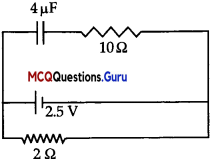
(A) 0 μC
(B) 4 μC
(C) 16 μpC
(D) 8 μC
Answer:
(D) 8 μC
Explanation:
As capacitor offer infinite resistance for DC circuit. So current from cell will not flow across branch of 4 μF and 10 Ω. So current will flow across 2 ohm branch.
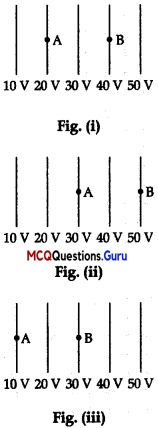
So Tktential Difference (PD) across 2 Ω resistance V = RI = 2 x 1 = 2 Volt. As battery, capacitor and 2 branches are in parallel. So PD will remain sanie across all three branches. As current does not flow through capacitor branch, so no potential drop will be across 10 Ω. So PD aaoss 4 ΩF capacitor = 2
Volt Q = CV= 2μF x 2V = 8μC
![]()
MCQ Of Electrostatics Class 12 Question 10.
A parallel plate capacitor is made of two dielectric blocks in series. One of the blocks has thickness d1 and dielectric constant k1 and the other has thickness d2 and dielectric constant k2 as shown in Figure. This arrangement can be thought as a dielectric slab of thickness d (= d1 + d2) and effective dielectric constant k. The k is:
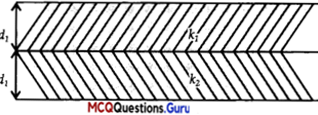
(A) \(\frac{k_{1} d_{1}+k_{2} d_{2}}{d_{1}+d_{2}}\)
(B) \(\frac{k_{1} d_{1}+k_{2} d_{2}}{k_{1}+k_{2}}\)
(C) \(\frac{k_{1} k_{2}\left(d_{1}+d_{2}\right)}{\left(k_{1} d_{1}+k_{2} d_{2}\right)}\)
(D) \(\frac{2 k_{1} k_{2}}{k_{1}+k_{2}}\)
Answer:
(C) \(\frac{k_{1} k_{2}\left(d_{1}+d_{2}\right)}{\left(k_{1} d_{1}+k_{2} d_{2}\right)}\)
Explanation:
Capacitance of a parallel plate capacitor filled with dielectric of constant k1 and thickness d1 is,
C1 = \(\frac{k_{1} \varepsilon_{0} A}{d_{1}}\)
Similarly, for other capacitance of a parallel plate capacitor filled with dielectric of constant k2 and thickness d2is,
C2 = \(\frac{k_{2} \varepsilon_{0} A}{d_{2}}\)
Both capacitors are in series so equivalent capacitance C is related as:
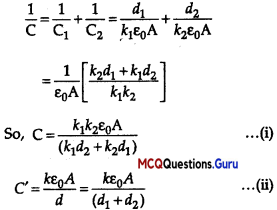
where, d (d1 + d2)
Comparing eqns. (i) and (ii), the dielectric constant of new capacitor is:
![]()
![]()
Class 12 Physics Ch 2 MCQ Question 11.
In the circuit shown in Figure, initially key K1 is closed and key K2 is open. Then K1 is opened and K2 is closed. Then
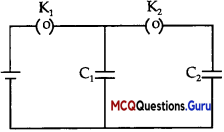
(A) Voltage across C1 = Voltage across C2
(B) Voltage across C1> Voltage across C2 , if C1 > C2
(C) Charge on C1 = charge on C2
(D) None of the above
Answer:
(A) Voltage across C1 = Voltage across C2
Explanation:
Since C1and C2 are in parallel, Voltage across C1 = Voltage across C2
Physics Chapter 2 MCQ Class 12 Question 12.
Capacitance of a parallel plate capacitor can be increased by –
(A) increasing the distance between the plates.
(B) decreasing the distance between the plates.
(C) decreasing the area of plates.
(D) increasing the thickness of the plates.
Answer:
(B) decreasing the distance between the plates.
Explanation:
C = k ε0A/d
So, capacitance does not increase by increasing the distance between the plates (d) or decreasing the area of the plates (A). Thickness of
plates has no connection with the capacitance of the capacitor.
![]()
Electrostatics Class 12 MCQ Chapter 2 Question 13.
A parallel plate capacitor is charged by connecting it to a battery. Which of the following will remain constant if the distance between the plates of the capacitor is increased in this situation?
(A) Energy stored
(B) Electric field
(C) Potential difference
(D) Capacitance
Answer:
(C) Potential difference
Explanation:
As the battery remains connected with the capacitor, the potential difference remain constant.
MCQs Of Physics Class 12 Chapter 2 Question 14.
4 capacitors, each of 2 ΩF, are connected as shown. What will be the equivalent capacitor across the points A, B?
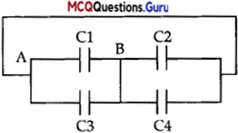
(A) 0.5 ΩF
(B) 2 ΩF
(C) 8 ΩF
(D) 4 ΩF
Answer:
(C) 8 ΩF
Explanation:
All the capacitors are connected in parallel. So the equivalent capacitance will be 8 ΩF.
MCQ On Electrostatics Class 12 Chapter 2 Question 15.
The capacitance of a parallel plate capacitor is 10 pF. When a dielectric plate is introduced in between the plates, its potential becomes 1/4th of its original value. What is the value of the dielectric constant of the plate introduced?
(A) 4
(B) 40
(C) 2.5
(D) none of the above
Answer:
(A) 4
Explanation:
C’ = KC (where K is the dielectric constant).
V = Q/C
V’ = Q/C’
V’ = V/4 = Q/C’ = Q/KC = V/K
∴ K = 4
Class 12 Physics Chapter 2 MCQ Questions And Answers Question 16.
Two spheres are separately charged and then brought in contact, so –
(A) total charge on the two spheres is conserved.
(B) total energy of the two spheres is conserved.
(C) Both (a) and (b)
(D) None of the above
Answer:
(A) total charge on the two spheres is conserved.
Explanation:
According to the few of conservation of charge, total charge on the two spheres is conserved.
![]()
Assertion And Reason Based MCQs (1 Mark each)
Directions: In the following questions, A statement of Assertion (A) is followed by a statement of Reason (R). Mark the correct choice as.
(A) Both A and R are true and R is the correct explanation of A
(B) Both A and R are true but R is NOT the correct explanation of A
(C) A is true but R is false
(D) A is false and R is True
MCQ Class 12 Physics Chapter 2 Question 1.
Assertion (A): Electric field is always normal to equipotential surfaces and along the direction of decreasing order of potential.
Reason (R): Negative gradient of electric potential is electric field.
Answer:
(A) Both A and R are true and R is the correct explanation of A
Explanation:
\(\overrightarrow{\mathrm{E}}\) = \(\overrightarrow{\mathrm{∆}}\)V
So, The electric field is always perpendicular to equipotential surface. Negative gradient of electric potential is electric field. So, direction of electric field must be in the direction of the decreasing order of electric potential.
![]()
MCQ Questions For Class 12 Physics Chapter 2 Question 2.
Assertion (A): Electric field inside a hollow conducting sphere is zero.
Reason (R): Charge is present on the surface of conductor.
Answer:
(A) Both A and R are true and R is the correct explanation of A
Explanation:
Since no charge resides in the surface of a hollow sphere, the electric field also zero inside. So assertion is true.
For hollow conducting sphere, the charged reside on the surface only. So, reason is also true and it explains the assertion properly.
Question 3.
Assertion (A): Work done in moving a charge between any two points in a uniform electric field is independent of the path followed by the charge between these two points.
Reason (R): Electrostatic forces are non conservative.
Answer:
(C) A is true but R is false
Explanation:
Work done in moving a charge between any two points in a uniform electric field = charge X potential difference. So, it is independent of the path followed by the charge. Hence the assertion is true. Electrostatic forces are conservative type. Hence, the reason is false.
![]()
Question 4.
Assertion (A): Electric potential and electric potential energy are two different quantities.
Reason (R): For a test charge Q and a point charge Q, the electric potential energy becomes equal to the potential.
Answer:
(C) A is true but R is false
Explanation:
Electric potential and electric potential energy are two different quantities. Hence the assertion is true. Electric potential is defined as the potential energy per unit charge. Hence V = PE/q So, the reason is false.
Question 5.
Assertion (A): When the distance between the parallel plates of a parallel plate capacitor is halved and the dielectric constant of the dielectric used is made three times, then the capacitance becomes three times.
Reason (R): Capacitance does not depend on the nature of material.
Answer:
(B) Both A and R are true but R is NOT the correct explanation of A
Explanation:
Initial capacitance = C2 = \(\frac{A \varepsilon_{0} k}{d}\)
Finally the capacitance = C2 = \(\frac{A \varepsilon_{0} 3 k}{(d / 2)}\)
So, C2 = 6C1
Hence the assertion is true.
From the expression of the capacitance, we find that capacitance depends on the area of the plates, dielectric constant and the distance between the plates. It does not depend on the nature of the material of the plates. Hence the reason is also true. But the reason cannot explain the assertion.
Question 6.
Assertion (A): Circuit containing capacitors should be handled very carefully even when the power is off.
Reason (R): The capacitors may break down at any time.
Answer:
(C) A is true but R is false
Explanation:
Even when power is off capacitor may have stored charge which may discharge through human body and thus one may get a shock. So, assertion is true. Breakdown of capacitors requires high voltage. So, reason is false.
Question 7.
Assertion (A): Capacity of a conductor is independent on the amount of charge on it.
Reason (R): Capacitance depends on the dielectric constant of surrounding medium, shape and size of the conductor.
Answer:
(A) Both A and R are true and R is the correct explanation of A
Explanation:
C = \(\frac{A \varepsilon_{0}}{d}\)
In the expression, there is no involvement of charge. So, capacitance is independent of charge. Hence the assertion is true.
It depends on permittivity of the surrounding medium and the area of the plate. So, reason is also true. Reason explains the assertion.
Question 8.
Assertion (A): Two parallel metal plates having charge +Q and -Q are facing at a distance between them. The plates are now immersed in kerosene oil and the electric potential between the plates decreases.
Reason (R): Dielectric constant of kerosene oil is less than 1.
Answer:
(C) A is true but R is false
Explanation:
Electric field for parallel plate capacitor in vacuum E = σ/ε0.
Electric field in dielectric = E’ = σ/Kε0.
Since the value of K for Kerosene oil is greater than 1, then E'< E. Hence the assertion is true. Dielectric constant of Kerosene oil is greater than 1. Hence the reason is false.
![]()
Case-Based MCQs
Attempt any 4 sub-parts out of 5. Each question carries 1 mark.
I. Read the following text and answer the following questions on the basis of the same:
Super capacitor:
Super capacitor is a high capacity capacitor with a capacitance value much higher than normal capacitors but with lower voltage limits. Such capacitors bridges the gap between electrolytic capacitors and rechargeable batteries. In automobile, bus, train, crane, elevator such capacitors are used for regenerative braking, short term energy storage or burst-mode power delivery. Super capacitors have many advantages over batteries: they are very low weight and generally don’t contain harmful chemicals or toxic metal.
They can be charged and discharged innumerable number of times without ever wearing out. The disadvantage is that super capacitors aren’t well-suited for long-term energy storage. The discharge rate of super capacitors is significantly higher than lithium-ion batteries; they can lose as much as 10-20% of their charge per day due to self¬discharge.
![]()
Question 1.
Capacity of super capacitor is:
(A) very low.
(B) medium.
(C) very high.
(D) may have any value.
Answer:
(C) very high.
Explanation:
Super capacitor is a high capacity capacitor with a capacitance value much higher than normal capacitors but with lower voltage limits.
Question 2.
Super capacitor makes a bridge between:
(A) electrolytic capacitor and rechargeable battery.
(B) single use battery and electrolytic capacitor.
(C) electrolytic capacitor and dynamo.
(D) electrolytic and non-electrolytic capacitors.
Answer:
(A) electrolytic capacitor and rechargeable battery.
Explanation:
Such capacitors bridges the gap between electrolytic capacitors and rechargeable batteries.
![]()
Question 3.
Super capacitors can be charged and discharged:
(A) few number of times.
(B) once only.
(C) several number of times but less than rechargeable batteries.
(D) several number of times much more than rechargeable batteries.
Answer:
(D) several number of times much more than rechargeable batteries.
Explanation:
Super capacitors can be charged and discharged innumerable number of times I without ever wearing out.
Question 4.
Self-discharge rate of Super capacitors:
(A) 10-20% of their charge per day
(B) 1 – 2% of their charge per day
(C) 0% of their charge per day
(D) 100% of their charge per day
Answer:
(A) 10-20% of their charge per day
Explanation:
The disadvantage is that super capacitors aren’t well-suited for long-term energy storage. The discharge rate of super capacitors is significantly higher than lithium- ion batteries; they can lose as much as 10-20% of their charge per day due to self-discharge.
Question 5.
Super capacitors are used for –
(A) degenerative braking.
(B) regenerative braking.
(C) small appliances.
(D) long time charge storage.
Answer:
(B) regenerative braking.
Explanation:
In automobile, bus, train, crane, elevator such capacitors are used for regenerative braking, short term energy storage or burst-mode power delivery.
![]()
II. Read the following text and answer the following questions on the basis of the same:
Capacitor Colour Code:
Capacitor values as written on small capacitors are sometimes misleading. Letters like p (pico) or n (nano) are used in place of the decimal point to identify its position and the value of the capacitor. For example, a capacitor labelled as n33 = 0.33nF, 8n2 = 8.2nF, 22n = 47nF and so on. Sometimes capacitors are marked with the capital letter K to signify a value of Kilo pico-Farads. As for example, a capacitor with the markings of 100K would be 1000 x 100 pF = 100 Kpf = 100 nF.
Sometimes, a three letter code consists of the two value digits and a multiplier. For example, the digits 471 = 47 x 10 = 470 pF, 332 = 33 x 100 = 3300 pf. To reduce these confusions an International colour coding scheme was developed almost same as that of resistance colour code.
| Band | Digit 1 | Digit 2 | Multiplier |
| Colour | |||
| Black | 0 | 0 | x 1 |
| Brown | 1 | 1 | x 10 |
| Red | 2 | 2 | x 100 |
| Orange | 3 | 3 | x 1,000 |
| Yellow | 4 | 4 | x 10,000 |
| Green | 5 | 5 | x 1000,00 |
| Blue | 6 | 6 | x 1,000,000 |
| Violet | 7 | 7 | |
| Grey | 8 | 8 | x 0.0 1 |
| White | 9 | 9 | x 0.1. |
Question 1.
What is the value of the capacitor if n27 is written on it?
(A) 0.27 nF
(B) 0.27 pF
(C) 27 nF
(D) 27 pF
Answer:
(A) 0.27 nF
Question 2.
Two capacitors marked as 221 and 220 respectively are joined in parallel. What is the total capacitance value?
(A) 441 pF
(B) 242 pF
(C) 242 nF
(D) 441 nF
Answer:
(B) 242 pF
Explanation:
The value of the capacitor marked as 221 is 220 pF. The value of the capacitor marked as 220 is 22 pF. When connected in parallel, the total capacitance = 220 pF + 22 pF = 242 pF.
![]()
Question 3.
68k is written on a capacitor. What is its value?
(A) 68 pF
(B) 68 nF
(C) 68 pF
(D)None of these.
Answer:
(D)None of these.
Explanation:
The value of the capacitor = 1000 x 68 pF = 68 kpF = 68 nF
Question 4.
What is the value of the capacitor bearing a colour code: brown, green, brown?
(A) 15 pF
(B) 15 nF
(C) 15 nF
(D) 150 pF
Answer:
(D) 150 pF
Explanation:
Brown, Green, Brown 15 x 10 = 150 pF
Question 5.
What will be the colour code of a 27 nF capacitor?
(A) Red, violet, black
(B) Red, violet, brown
(C) Red, violet, orange
(D) None of the above
Answer:
(C) Red, violet, orange
![]()
Explanation:
Red, violet, orange → 27 x 1000
27000 pF = 27 nF
III. Read the following text and answer the following questions on the basis of the same:
Power factor corrector capacitor:
Power factor correction is a method to reduce the lagging power factor in inductive loads by fixing a high value capacitor across the phase and neutral line close to the load. When the Voltage and Current are in phase with each other in an AC circuit, the energy from the source is fully converted into another form to drive the load and in this case power factor is in unity. When the power factor drops, the system becomes less efficient.
In inductive loads, current “lags” the voltage leading to “lagging power factor”. Power factor correction is the method to reduce the lagging power factor in inductive loads by fixing a high value capacitor across the phase and neutral close to the load. These capacitors have leading power factor so that it will neutralize the lagging power factor of the load. Power capacitors are huge non polarized metal film electrolytic type capacitors.
Capacitors should be sufficiently rated to the load capacity. It should be connected to the lines, only when the loads are running and drawing current
Question 1.
What is meant by power factor correction?
(A) The method to reduce the lagging power factor in inductive loads
(B) The method to enhance the lagging power factor in inductive load
(C) The method to reduce the lagging power factor in capacitive loads
(D)The method to enhance the lagging power factor in capacitive loads
Answer:
(A) The method to reduce the lagging power factor in inductive loads
Explanation:
Power factor correction is the method to reduce the lagging power factor in inductive loads by fixing a high value capacitor across the phase and neutral close to the load.
![]()
Question 2.
When the energy from source is fully converted into another form, the power factor is
(A) 0.5
(B) 1.0
(C) 0
(D) ∞
Answer:
(B) 1.0
Explanation:
When the voltage and current are in phase with each other in an AC circuit, the energy from the source is fully converted into another form to drive the load and in this case, power factor is unity. When the power factor drops, the system becomes less efficient.
Question 3.
Power capacitors for power factor correction are –
(A) polarized metal film electrolytic type.
(B) non-polarized metal film electrolytic type.
(C) non-polarized metal film non-electrolytic type.
(D) polarized ceramic non- electrolytic type.
Answer:
(B) non-polarized metal film electrolytic type.
Explanation:
Power capacitors are huge I non polarized metal film electrolytic type capacitors.
Question 4.
Power capacitors for power factor correction have –
(A) lagging power factor.
(B) leading power factor.
(C) leading or lagging power factor depending on the value of the capacitor.
(D) leading or lagging power factor depending on the type of load.
Answer:
(B) leading power factor.
Explanation:
Power factor corrector capacitors have leading power factor so that they neutralize the lagging power factor of the inductive load.
![]()
Question 5.
Power factor corrector capacitors should be connected –
(A) across the phase and ground near the inductive load.
(B) across the phase and neutral away from the inductive load.
(C) across the phase and neutral near the inductive load.
(D) across the neutral and ground near the inductive load.
Answer:
(C) across the phase and neutral near the inductive load.
Explanation:
Power capacitors are connected across the phase and neutral near the inductive load such as motor.